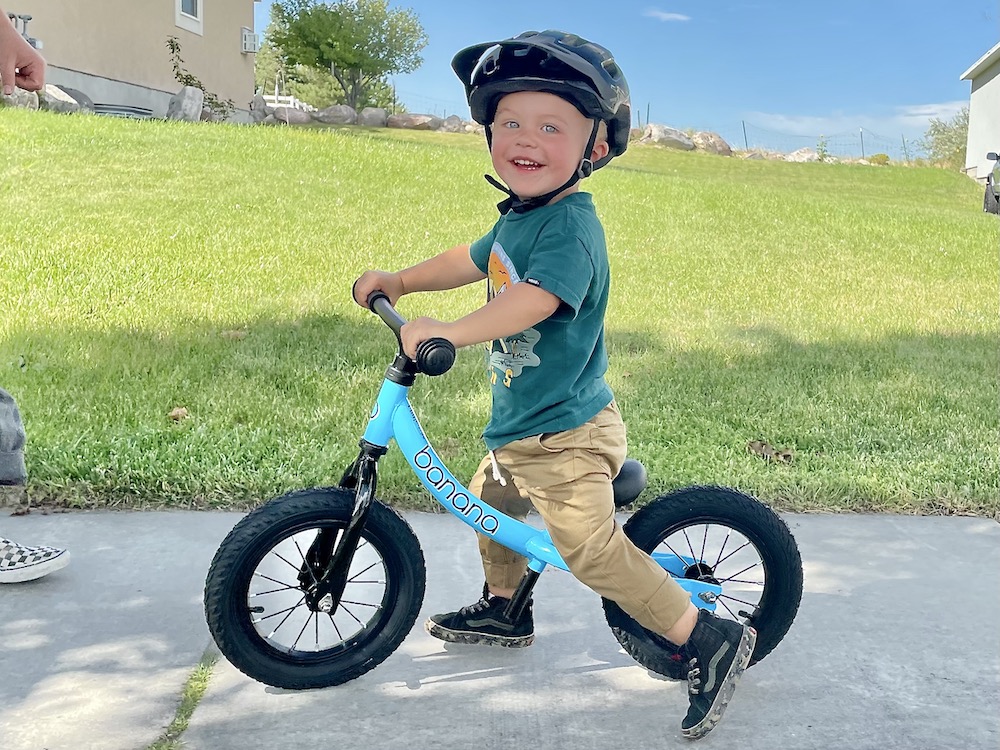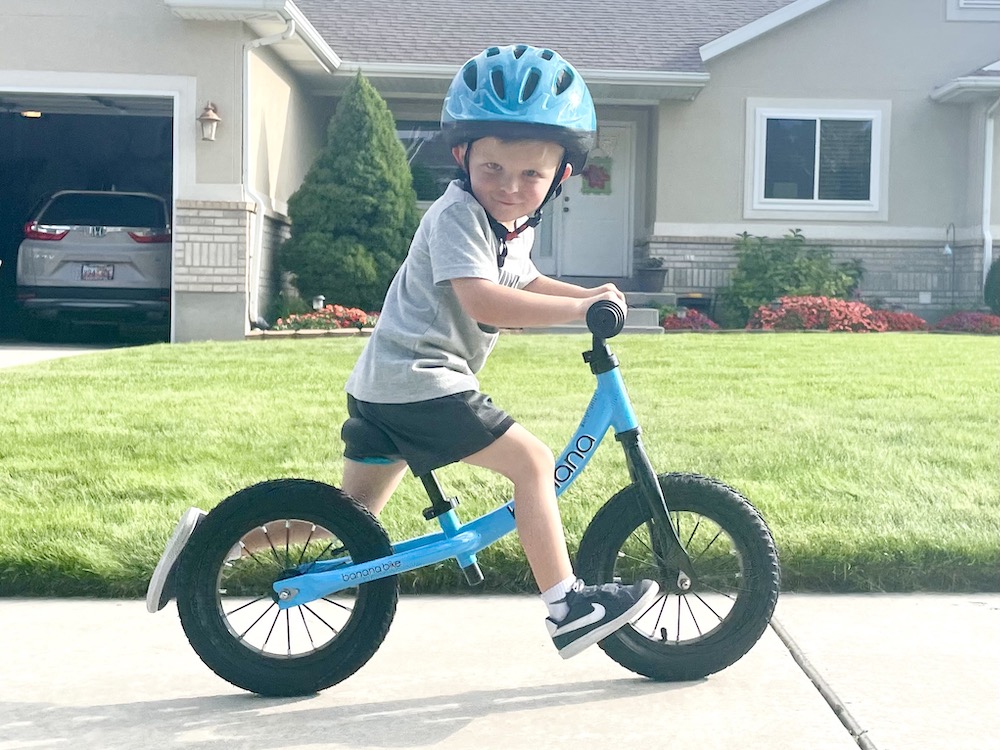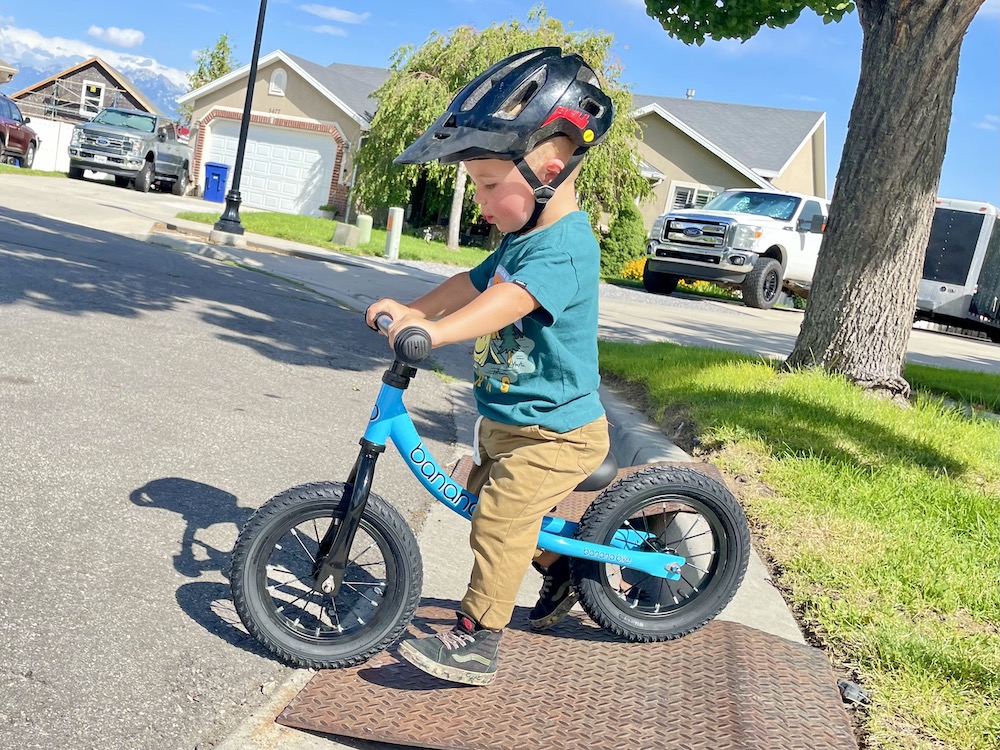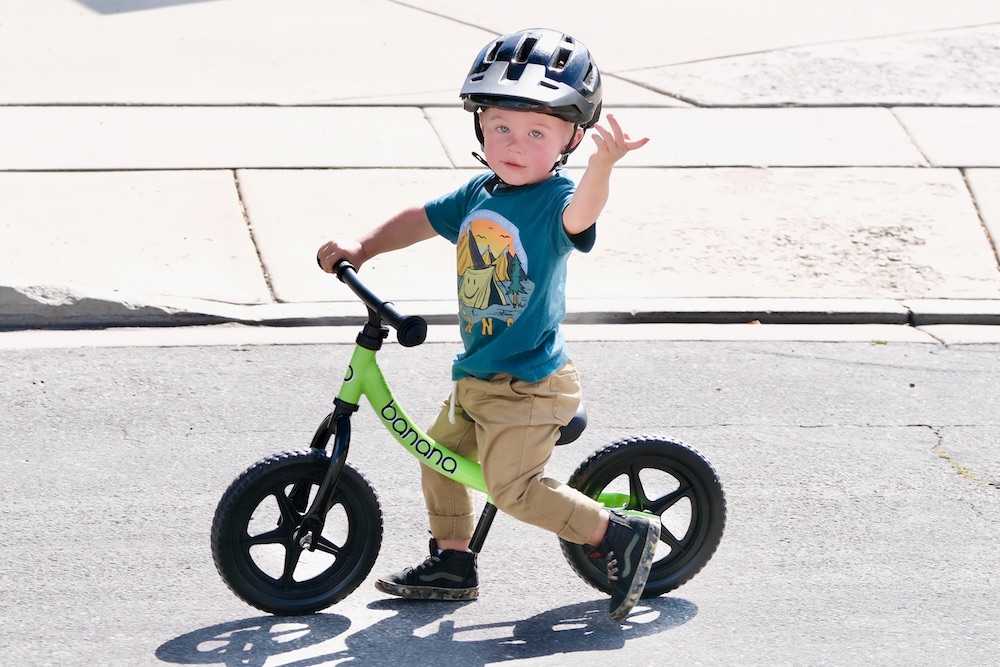The Banana Bike is hands-down one the best budget balance bikes we’ve ever tested. Having thoroughly tested more than 200 balance bikes over the years, we can confidently say that the Banana Bike is a great choice for those on a tighter budget.
Available in two models – the Banana GT with air tires and the Banana LT with foam tires – both bikes feature a long, sturdy frame which helps to create a steady, easy-to-balance bike. Read the review below for all the details!

Banana Bike Overview

RATING: Recommended
MSRP: Prices on all three models fluctuate often
BEST FOR: Budget-minded families with a child in 2T to size 4T pants.
SEAT HEIGHT (all models): 13″ – 17″
WEIGHT: GT (air tires): 8.4 lb.; LT (foam tires): 6.6 lb.
BRAKES: None
PROS:
- Great geometry and performance for the price
- Quick release seat post clamp
- Air tires at a great price!
- Handlebars on all three bikes are height adjustable
CONS:
- As with all budget bikes, it’s not as durable as the other bikes we recommend
- Handlebars often come out of alignment as a result of a crash or the bike just falling over (common on all budget bikes)
- Requires much more assembly than other bikes, but is not challenging
- Frame and sticker decals easily scratch off
Banana Bike Review – Results of our Test Rides
We’ve tested several different Banana Bikes over the years, and as Banana Bike continues to innovate, we make sure to get our hands on the latest models so that we can speak to their newest changes. This written review covers their current GT and LT model. This review also briefly mentions an “LTF model” that features a footrest, but that model is no longer available.
After testing out all three models, we can attest that Banana Bike’s line of budget balance bikes are great little bikes for families on a tighter budget.

Banana Bike Models and Sizing
All three Banana Bike models are almost identical in size and are all a great fit for kids with inseams ranging from 13″ – 18″. We tested out both balance bikes with toddlers ranging from 2 to 4 and they fit great on all three models. The best Banana Bike model for you depends only on what features you are looking for in a balance bike.

The ONLY difference between the two models is whether the bike has air or foam tire (we discuss the pros and cons of tire types below).

| Banana Bike GT | Banana Bike LT | |
|---|---|---|
| Tires | Air | Foam |
| Seat Height | 13″ – 17″ | 12.75″ – 16.75″ |
| Weight | 8.36 lb. | 6.61 lb. |
| Quick Adjust Seat Post | ✔️ | ✔️ |
Both bikes have the same handlebar, headset, seat post collar, and saddle. In this review, the GT model is blue and the LT is green (there is also a single image of a pink LT). Due to the taller air tires on the GT, its seat height is slightly taller and the bike is slightly heavier.
With the pricing of the Banana Bikes varying widely online, we have not included them in this review, but on average the GT model with air tires tends to be about $10 more than the LT.
Due to inconsistencies in the image and titles of Banana Bike’s Amazon listings, be aware that it can be confusing to differentiate between the models, so be sure to not just look at the images (mainly the different tires) when ordering. The seat heights listed on Amazon can also greatly vary, the measurements we have listed are accurate as of January 2024 (based on the bikes we purchased off Amazon).
What are the benefits of air tires? – Balance Bike GT vs LT
While there are certainly benefits to the foam tires found on the LT, we much prefer the air tires on the GT model. Although air tires do add to the weight of the bike and do run the risk of going flat, they provide much more traction and cushioning for the rider. As a result, the GT provides a smoother ride as the air tires are able to compress and absorb bumps along the way.

The solid foam tires on the LT will never go flat, but they cannot compress and do not provide any cushioning benefits. The solid foam also cannot flex and conform to the ground like the rubber air tires, and therefore do not provide nearly as much traction, especially on non-paved surfaces.

The rubber air tires on the GT also surround metal rims versus plastic rims on the LT. The plastic rims on foam tires wheels are prone to getting out of “true” (aka have a slight wobble when rolling), while the metal rims are much more durable.
| Model | Banana Bike GT | Banana Bike LT |
| Tire Type | Air | Foam |
| Rim Material | Metal | Plastic |
| Cushioning | High | Very Low |
| Traction: Paved | High | Medium |
| Traction: All terrain | High | Low |
| Risk of Puncture | High | None |
While we love air tires, the thorn in their side (quite literally) is their tendency for going flat. While a good dose of tire sealant can do wonders for preventing flats, we also understand that many parents don’t want to deal with the risk of flat tires. With foam tires, flats will never been an issue. Your child can ride through a huge patch of goat-head thorns and their tires will still roll on!

So while we can confidently say that air tires outperform foam tires in all types of riding, if you need a maintenance-free bike and don’t have the time or energy to worry about flats, foam tires may be the best option for you! For the average rider sticking to mainly pavement, foam tires perform just fine.
What are the benefits of a footrest? – Balance Bike LT vs LTF*
A well-designed footrest can be fun for more advanced riders, but they certainly aren’t necessary. Some kids love footrests on balance bikes, while others never use them! So should you get the LT or the LTF? (*The LTF is no longer available but we left this section in in case it ever comes back)
Over the years we have found that kids who lean more towards the adventurous side tend to use footrests more than kids who are slightly more timid. That being said, in order to use a footrest, a rider must already be comfortable running and gliding on their balance bike. As a result, a footrest is only used by more advanced riders who are already confident and capable.

So what do kids do with their feet if they don’t have a footrest? It’s not a problem! Kids naturally just lift up their feet and glide. In fact, we’ve never had a test rider ask what to do with their feet while riding a balance bike, but we’ve had plenty of parents :).

Prior to learning how to glide, footrests can be problematic for young walkers as they can get in the way of their stride, but we didn’t have that problem with the Banana Bike. Even with the seat set to its minimum the footrest on the LTF did not get in the way of our 2-year-old tester’s stride. We would anticipate, however, that the footrest would be in the way of the stride of really petite kids with narrow frames.

All in all, if you’re debating on whether or not to get a footrest, we tend to prefer bikes without them as it’s one less thing for kids to think about while riding. But if you anticipate your child becoming more adventurous on their bike as they age and you plan on purchasing a bike with foam tires, then we would go for the LTF model.
With all kids, however, if riding on dirt or non-paved surfaces is anticipated, we would recommend going with the air tires on the GT over the LT or the LTF.
Banana Bike Components
Headset and Handlebars
All three bikes feature the same handlebar and headset. Like most budget balance bikes, the headset isn’t a “true” headset, but rather a simple clamp that holds the handlebars in place. The clamp is not quick-release and requires an 5mm Allen key to adjust.

While the clamp holds strong while riding, be aware that this style of headset easily and often comes out of alignment when the bike is set down firmly or the child crashes. Anticipate realigning the handlebars to the front wheel before every ride and certainly after any crashes. To do so, simply hold the front wheel between your feet and twist the handlebars back into proper alignment.
Having to realign handlebars is very common with budget balance bikes. One benefit of higher-end balance bikes is their true headsets that hold strong enough to prevent the handlebars from twisting in the event of a crash.
The benefit of not having a true headset, however, is the ability to raise the handlebars on the Banana Bikes. All three models are able to raise their bars 2.5″. This will help the bike be a comfortable fit as your child grows and you raise the saddle.

Seat Post
The seat post on all models has a quick release clamp and can easily be adjusted without heading to the tool box. While the clamp is easy to adjust, it does tend to come off the frame when adjusting, so be sure to realign it properly when re-tightening. (The opening of the clamp should line up with the opening on the frame.) When aligned properly, the clamp is more likely to hold the post securely and not allow it to twist or slide down.

Even at the minimum seat height, all models have plenty of ground clearance with over 4″ of room between the bottom of the post and the ground. This allows for plenty of space for younger riders to get adventurous going down curbs or steps without hitting the bottom of the post on the ground.
Saddle
All models share the same padded saddle. The saddle does come a with a grab handle, but the handle is pretty small and we found it easier to carry the bike by its frame.

Exposed Axle Bolts
On the down side, all models have exposed front and rear axle bolts (as opposed to flush bolts that barely stick past the bike’s frame). These bolts are found on all budget balance bikes and over time they easily get dented and roughed-up, which can cause them to scratch the legs of young riders.

Cheap Sticker Decals
Another common but minor downside of budget bikes is stickers versus embedded decals on the frame. The stickers on all Banana Bike models are very thin and tear easily and quickly. The same could be said for the paint. All three models had significant scratches on the frame and handlebars after our first testing session.

Considering these are just cosmetic concerns, it doesn’t affect the overall performance of the bike. But don’t expect any of the Banana Bike models to look shiny and new for very long!
Banana GT/LT Balance Bike Comparison
The Banana Bike models are great for the price, but when compared to other budget bikes, the GT really shines. With air tires on metal rims, the GT is better equipped to handle just about anything a child can throw at it.
To provide a more stable riding experience for older and taller riders, the Banana Bike has a longer wheelbase (measurement between the front and rear axle of the bike), measuring 22″. While many high and low budget balance bikes have a similar wheelbase, other budget bikes have shorter, less-stable wheelbases, such as the Chillafish Charlie’s with a 19″ wheelbase.

Like all budget balance bikes, the Banana Bike, as well as the other models mentioned below, don’t come near to the quality found in most balance bikes in the $150+ range. That additional expense typically buys you higher-quality components, a lightweight aluminum frame, and a handbrake for quicker stops.
Banana Bike GT: Our top budget-friendly pick for riders planning on riding various terrains as well as those hitting up jumps and curbs.
Banana Bike LT: Featuring the basic same frame and design of the GT, but with foam tires, the LT is best for neighborhood riders who plan to ride mainly on paved surfaces.
GOMO: The GOMO is amazingly built and features quick-release adjust handlebars and seat post. We found the GOMO required less assembly and the handlebars held in place a bit better than the Banana Bike. So if you’re looking for foam tires at a similar price point to the Banana Bike LT, the GOMO is a great option.
Strider Classic: A true classic that doesn’t disappoint, the Strider is a solid bike if you need additional room for your child to grow into it. Strider sells an extended seat post that allows the seat height to raise up to 19″. The Strider has a lower minimum seat height and is better suited for toddlers ages 18-months (as long as their inseam is at least the same height as the minimum seat height of 11″) to 4-years-old.
| Banana GT | Banana LT | Strider Classic | GOMO | |
| Tire Type | Air | Foam | Foam | Foam |
| Seat Height | 13″ – 17″ | 12.75″ – 16.75″ | 11″ – 16″ | 12.5″ – 16″ |
| Weight | 8.36 lb. | 6.61 lb. | 6.4 lb. | 8.5 lb. |
| Footrest | – | – | ✔️ | ✔️ |
| Quick Adjust Seat | ✔️ | ✔️ | ✔️ | ✔️ |
| Handlebar Adjusts | ✔️ | ✔️ | ✔️ | ✔️ |
| Link to Review | Review | Review |
Bottom Line on the Banana Bike Balance Bike
Better quality and a better design than most budget balance bikes, the Banana Bike balance bikes offer a great design at a family-friendly price. With air tires, the GT model really stands out compared to other balance bikes with foam tires..
Banana Balance Bike Video Review – Older Models
Visual learner? Check out our Banana Bike video review, but be aware that this review covers the older model of the Banana Bike. The GT model in this review no longer has a true headset. It shares the same headset as the LT models.
FTC Disclosure: Affiliate links are included in this review. No monetary compensation was provided for this review. The reviewed products were purchased by Two Wheeling Tots and not supplied by the manufacturer or distributor to help facilitate this review. All opinions and images are that of Two Wheeling Tots LLC. All content and images are copyrighted and should not be used or replicated in any way. View our Terms of Use.
